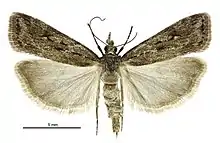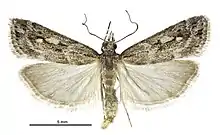Eudonia ustiramis
Eudonia ustiramis is a species of moth in the family Crambidae. This species is endemic to New Zealand. It is classified as "Data Deficient" by the Department of Conservation.
| Eudonia ustiramis | |
|---|---|
 | |
| Female | |
 | |
| Male | |
| Scientific classification | |
| Domain: | Eukaryota |
| Kingdom: | Animalia |
| Phylum: | Arthropoda |
| Class: | Insecta |
| Order: | Lepidoptera |
| Family: | Crambidae |
| Genus: | Eudonia |
| Species: | Eudonia ustiramis |
| Binomial name | |
| Eudonia ustiramis | |
| Synonyms[2] | |
| |
Taxonomy
This species was described by Edward Meyrick in 1931 using a specimen collected by S.C. Patterson in Whangārei in January and named Scoparia ustiramis.[3][2] George Hudson discussed and illustrated this species in his 1939 book A supplement to the butterflies and moths of New Zealand.[2][4] In 1988 John S. Dugdale assigned this species to the genus Eudonia.[2] The holotype specimen is held at the Natural History Museum, London.[2]
Description
Meyrick described the species as follows:
♂ 16 mm. Head, thorax grey mixed white. Palpi dark grey, apical edge white. Forewings elongate-triangular, termen slightly rounded, oblique; grey, costal and dorsal thirds suffusedly irrorated white; an irregular streak of black irroration beneath cell from base to end; a slenderer black streak in cell from middle to end, terminating in a white dot on angle of cell, and five rather irregular black lines on veins to termen, black dots on ends of terminal veins: cilia whitish-grey, a light grey subbasal line. Hindwings light grey; cilia pale grey, a darker subbasal shade.[3]
The wing pattern of this species is variable and the holotype has strong dark longitudinal streaks on its forewings.[5] Other specimens of this species have been confirmed through the comparison of male genitalia.[5]
Distribution
This species is endemic to New Zealand.[6][1] For many years this species was only known from its type locality.[5] However, in recent years it has been identified as a very locally common species of Northland and Auckland.[5]
Habitat
This species is known to inhabit gumland heaths.[5]
Conservation status
This species has been classified as having the "Data Deficient" conservation status under the New Zealand Threat Classification System.[7]
References
- "Eudonia ustiramis (Meyrick, 1931)". www.nzor.org.nz. Landcare Research New Zealand Ltd. Retrieved 27 January 2018.
- Dugdale, J. S. (1988). "Lepidoptera - annotated catalogue, and keys to family-group taxa" (PDF). Fauna of New Zealand. 14: 158. Archived from the original (PDF) on 27 January 2019. Retrieved 27 January 2018.
- Meyrick, E. (1931). "New species of New Zealand Lepidoptera". Transactions and Proceedings of the Royal Society of New Zealand. 62: 92–97 – via National Library of New Zealand.
- Hudson, G. V. (1939). A supplement to the butterflies and moths of New Zealand. Wellington: Ferguson & Osborn Ltd. p. 423. OCLC 221041540. Retrieved 4 June 2018.
- Hoare, R. J. B.; Rhode, B. E.; Emmerson, A. W. (2012). "Larger moths of New Zealand: Image gallery and online guide. : Notes on Scopariinae". www.landcareresearch.co.nz. Retrieved 4 June 2018.
- Gordon, Dennis P., ed. (2010). New Zealand inventory of biodiversity: Kingdom animalia : chaetognatha, ecdysozoa, ichnofossils. Vol. 2. p. 458. ISBN 978-1-877257-93-3. OCLC 973607714. OL 25288394M. Wikidata Q45922947.
- Hoare, R.J.B.; Dugdale, J.S.; Edwards, E.D.; Gibbs, G.W.; Patrick, B.H.; Hitchmough, R.A.; Rolfe, J.R. (2017). "Conservation status of New Zealand butterflies and moths (Lepidoptera), 2015" (PDF). New Zealand Threat Classification Series. 20: 8.